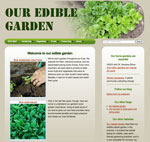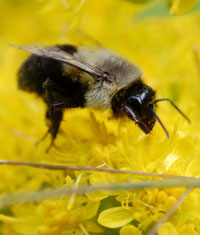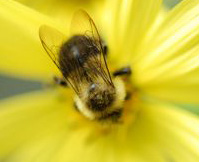| Inspiring example of stewardship | |
|
A group of indigenous women in Mexico are challenging ancient social norms in order to preserve an endangered native species: the stingless bee known as Melipona Beecheii. Traditionally the prerogative of men in Mayan culture, beekeeping is providing this collective with a source of income and a reason to keep the species from going extinct. See this five-minute video at https://www.youtube.com/watch?v=4c4v1E2mRhw
|
| Organic chocolate and birds of Hispaniola | |
|
An Onondaga Audubon program Wednesday, April 9, 7 p.m. Onondaga Lake Visitors Center Adjacent to I-690 on the southwest shore of Onondaga Lake As a graduate student at SUNY-ESF, Andrea Thomen has been studying the importance of agroforestry for bird species in the Caribbean. In this program, she will explain how birds can help promote sustainable livelihoods in the tropics. For directions visit
|
| Learn to grow your own food | |
| Our land can grow food not only for creatures, but for ourselves.
John Allen of Edible Gardening CNY will present a number of programs this spring about how you can grow your own food.
For dates and times, visit Edible Gardening CNY at www.egcny.org.
|
HGCNY Officers
| |
| President:
Janet Allen
Vice-President:
Carol Biesemeyer
Treasurer:
Randi Starmer
Secretary:
Soule Leiter
Membership:
Linda Rossiter
Program Chair:
Carol Biesemeyer
Newsletter Editor:
Janet Allen
Additional Planning Committee Members:
Beth Mitchell
Dave Mitchell
John Allen
|
| Our Habitat Garden |  |
Visit Our Habitat Garden website for information on providing habitat, earth-friendly gardening practices, plants, and various creatures here in Central New York. TIP: Click on each sliding menu item as you navigate through the menus to pin them down instead of sliding away.
|
| HGCNY on Facebook |
As as more of us participate on our Facebook page, this will become a useful resource for asking (and answering!) local HGCNYers' questions about habitat gardening. |
|
Join HGCNY!
|  |
Becoming an official member of HGCNY is easy: just join Wild Ones! Basic household membership is $37/year, but there are other options, too. (See membership application or website.)
Wild Ones
P.O. Box 1274
Appleton, Wisconsin 54912-1274
Make checks payable to Wild Ones.
Or telephone toll-free 877-394-9453.
|
|
Our Edible Garden
|  | Visit OurEdibleGarden.org to see an example of a Central New York edible garden, the perfect companion to your habitat garden.
|
|
 | Black cohosh
(Cimicifuga racemosa)
|
It may be hard to imagine right now, but our beautiful perennial plants really ARE under all that snow, getting ready to emerge.
And our March meeting will help you create even more of these beautiful and valuable plants.
We're welcoming back Ellen Folts, owner of Amanda's Garden, who will present Encouraging Nature: Propagating, Growing and Using Native Perennials.
Native perennials meet the needs of native pollinators and fill a vital role in the garden. Locally grown native perennials produced by seed are adapted to the area in which they are produced, and propagating these plants is relatively easy once their germination requirements are met. She will discuss seed propagation techniques, along with garden uses of various native woodland plants that can be propagated in this manner.
WHEN: Sunday March 30 at 2:00 pm WHERE: Liverpool Library (Directions)
We meet the last Sunday of the month, and our meetings are free and open to the public. Come and bring a friend!
THIS FRIDAY and SATURDAY
The 6th Annual Ithaca Native Landscape Symposium March 7th and 8thThe Symposium offers alternative ideas, knowledge and perspectives presented by experts and professionals from our region and beyond. It's not just for professionals. Master Gardeners, homeowners, naturalists and anyone else eager to learn more about this growing movement are welcome! For more information and to register ...Habitat presentations
 I'll be doing some presentations. Sat. March 8: Pollinators at the Ithaca Symposium (details above).
Thurs. March 13 at 7:30 pm: Creating a Bird-friendly Yard at Beaver Lake Nature Center (For more information ...)
Wed. March 26 at 7:30 pm: Gardening for Nature, the monthly Sierra Club program held at University UMC at 1085 E. Genesee St, Syracuse
Janet Allen
President, HGCNY
|
|
 | Helianthus annuus
from the Greek "helio" meaning "sun" and "anthos" meaning "flower";
"annuus" means "annual."
|
Sunflowers: Annuals and Perennials
The good news about sunflowers -- besides the cheer they bring to our own lives -- is that this native plant is easy to grow and beneficial to many creatures, such as bees and birds.
Native Americans originally cultivated these plants and used them for many purposes. And in the Northeast, sunflowers were part of the Onondaga creation myth.
Some sunflowers are annuals and some are perennials.
Annual sunflowers
The common sunflower ( Helianthus annuus) has large, showy flowers, with a central maroon disk surrounded by bright yellow rays. But it's not the same as the State Fair-worthy 'Mammoth' sunflower, which was developed in Russia from our sunflower. H. annuus is a widely branching plant with many flowerheads that are large, but not as large as the Mammoth's flowers; a tall plant (2-8 feet), but not as tall as the Mammoth. Annual sunflowers are easy to grow. Just plant in full sun in well-drained soil. You can direct-sow or start them inside a few weeks before the last frost. Some suggest planting them in a 4-inch deep furrow and gradually filling it in as the plant grows. This creates a deeper-rooted plant. Once established, they're fairly drought-tolerant. CAUTION: If you buy seedlings, make sure you buy organically-grown plants that haven't been treated with pesticides! Pollen-less sunflowers!?!Pollen-less sunflowers are available. They have nectar, but fewer seeds for birds and, of course, no pollen for the bees. But bees collect pollen to feed their young! These aren't a good choice for a habitat garden! Lemon Queen sunflowerWild Ones doesn't promote using cultivars of native plants since they don't always have the habitat properties the species has, but in the case of H. annuus, there's an exception. The 'Lemon Queen' cultivar has been selected for use in the Great Sunflower Project, a citizen science project that is helping collect information about the bee population throughout the country. So if you'd like to participate in this family-friendly project, choose this cultivar. More information is at www.greatsunflower.org/ . Next newsletter: Perennial sunflowers |
 Keeping the migration going
We already know that this winter's monarch population was at an all-time low, occupying a mere .67 hectares!
As Jim Lovett of Monarch Watch reports,
Monarch numbers will rebound but only if the weather allows AND there is enough milkweed to increase the population. While we will never get back to the large populations of the 1990s, there is still enough milkweed to produce monarchs in sufficient numbers to colonize 3-4 hectares of the forests in Mexico. However, given the current size of the overwintering population it is likely that it will take 2-3 years with relatively favorable breeding conditions for the population to attain such numbers.
So plant milkweed here, there, and everywhere!
As Dr. Chip Taylor of Monarch Watch said in an interview: "The question is, can all of us make a difference? We have a choice here: to let this migration dwindle away, or do our damnedest to keep it going."
For a more detailed discussion of the monarch population status, visit the Monarch Watch blog at http://monarchwatch.org/blog/ . |
|
Just what are those neonicotinoids?
 The "neonics" have been in the news a lot lately since they're suspects in the decline of bees. The "neonics" have been in the news a lot lately since they're suspects in the decline of bees.
But what are they? Chances are you don't see a big "Neonicotinoid" sign in stores, but they're there nevertheless, components of easier-to-say, more well-known pesticides, such as, for just one example, Bayer Advanced All-in-One.
Neonicotinoids are systemic chemicals. They are absorbed by the plant and dispersed through plant tissues, including pollen and nectar. They're often described as "safe" since they don't harm humans or mammals. BUT they're toxic to bees and other beneficial insects and can linger in the soil for months or even years. The Xerces Society reports that when exposed to neonics, bumble bee colonies grow more slowly and produce fewer new queens. The Great Sunflower Project, whose data suggests that these chemicals are having a negative influence on bees, has compiled a list of these products at www.greatsunflower.org/GardenNeonictinoids . The Xerces Society recommends that you avoid using neonics in your yard. If you choose to use a pesticide (and you can have a beautiful garden without using any pesticides), read the label to determine whether a product contains any of these neonics: imidacloprid, acetamiprid, dinotefuran, clothianidin, or thiamethoxam. And when purchasing plants, ask the garden center staff if the plants have been treated with any of these chemicals. Buy organically produced plants or plant your own organic seeds. |
|
|
|
|